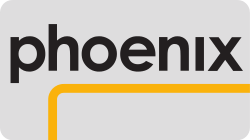Phoenix (German TV station)
| Phoenix | |
|---|---|
 | |
| Launched | 7 April 1997 |
| Owned by | ARD, ZDF |
| Picture format |
16:9 576i50 720p50 (HDTV) |
| Country | Germany |
| Language | German |
| Broadcast area | Germany |
Availability | |
| Terrestrial | |
| DVB-T | Various; region dependent |
| Satellite | |
| Astra 1L (19.2°E) | 10743.75 H 51 22000 5/6 (DVB-S) |
| Astra 1M (19.2°E) | 11582.25 H 25 22000 2/3 (HDTV DVB-S2) |
| Cable | |
| Kabel Deutschland (Germany) | Yes (part of basic package)[1] |
| Streaming media | |
| FilmOn | Watch live |
Phoenix is a publicly funded television station in Germany which is produced jointly by public broadcasting organizations ARD and ZDF. It broadcasts documentaries, news, special events coverage and discussion programmes. Phoenix's headquarters are in Bonn, the former West German capital.
Programming
Phoenix broadcasts a deaf-subtitled version of the Tagesschau, ARD's flagship news broadcast, and ZDF's premier news broadcast Heute-Journal, in German Sign Language.
The channel's flagship news broadcast is Der Tag ("The Day"), which airs from 11:00 pm to midnight. Its length enables extended reports and interviews to be included.
The show Vor Ort ("On Scene") includes live coverage of political events, public lectures by important personalities, press conferences and assemblies of the Bundestag and Bundesrat.
Daily talk shows like Phoenix Runde (Phoenix Roundtable) with Pinar Atalay or Alexander Kähler, Unter den Linden with Michaela Kolster or Michael Hirz, discuss current topics with experts or politicians.
As a benchmark in coverage, a "Meet the Press"-like show, Internationaler Frühschoppen is broadcast Sunday at 12 noon when the ARD's Presseclub is not broadcast.
The series "Historische Debatten" ("Historical Debates") and "Historische Ereignisse" ("Historical Events"), with journalist Helmut Illert, examine important topics relating to the development of the Federal Republic of Germany.
Phoenix is comparable to the American channel C-SPAN or the British BBC Parliament, because they also cover government and national politics.
Creation
The creation of Phoenix is credited to the former chancellor Helmut Kohl, who wanted to create a "European Parliamentary Channel". However, the idea was rejected due to criticism by the public channels (ARD and ZDF) and suspicion that political pressure from Kohl could lead to a "Helmut-Kohl-Channel".
The real idea for "Phoenix - Der Ereignis- und Dokumentationskanal" ("Phoenix - the current affairs and documentary channel") came from viewers of ARD and ZDF, who wanted a "media-political correction of faults in the system of information transfer". This created the opportunity to create a "Parliamentary Channel", with the aim of increasing credibility and satisfying consumer demand.
Private channels (RTL and Sat. 1) criticized the creation of Phoenix because they were at the time creating their own news channels (n-tv and N24 respectively).
The headquarters of Phoenix were provisionally situated in Cologne. However, in 2000, the headquarters were relocated to studios in Bonn.
Phoenix's highest ratings to date were in August 2006, when it had 1.0% viewer share. With about 4.5 million viewers, it had more viewers than N-TV and N24.[2]
Alignment of programming
Phoenix's stated aim is it to create "balance of the shortening of information, which are seen in news and magazines on television". The programming should be a "truthful illustration of the reality in correspondence with the constitutional order of the publicly-funded broadcast and television stations in Germany". The target is fulfilled with current reportages and documentaries from the vast archive of ARD and ZDF, as well as international productions from Discovery Channel and the BBC, dubbed into German.
Availability
- Digital terrestrial television (DVB-T)
- analogue cable
- Digital cable (DVB-C)
- Digital satellite television
- livestream (only a few shows are streamed online)
External links
Sources
- ↑ "Kabelfernsehen: Übersicht aller TV-Sender - Kabel Deutschland" [Cabel Television: overview of all TV stations - Kabel Deutschland] (in German). Kabel Deutschland. Retrieved 2 May 2012.
- ↑ "Presseportal: PHOENIX mit 1 Prozent Marktanteil vor N24 und n-tv". Presseportal.de. Retrieved 2012-03-14.